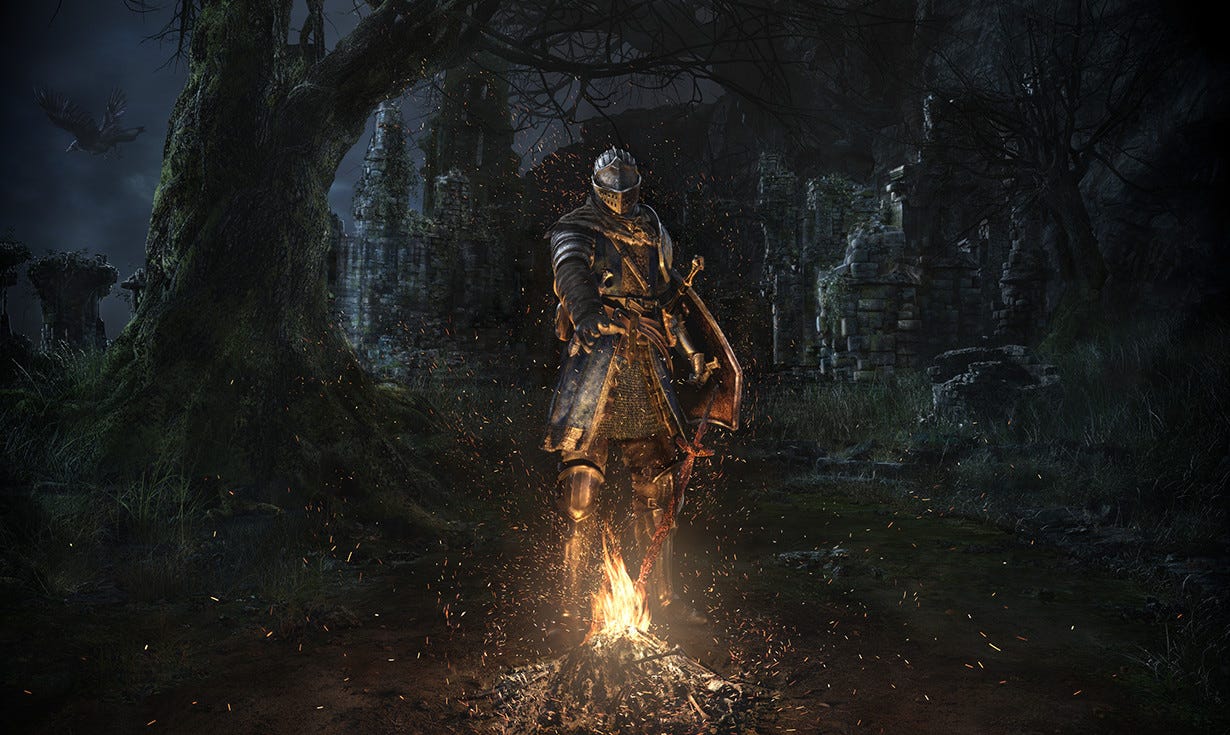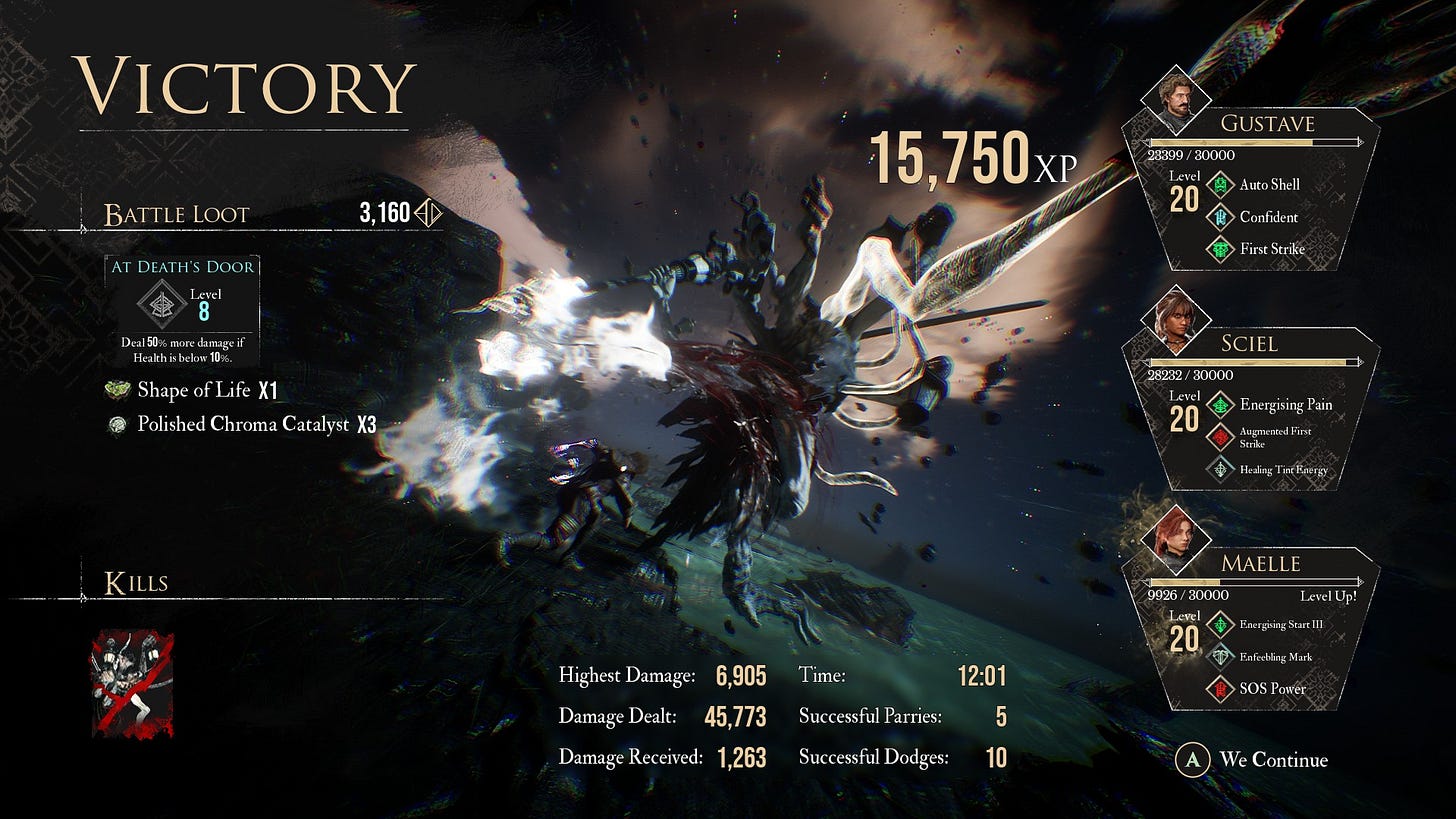What is a Soulslike game?
Get your oversized pitchforks ready, we're going to tackle the sacred cow!
Look at any of my gaming-related bios online, and you will see no mention of Souls games. I’m not a Souls gamer whatsoever. In fact, in many private conversations, I have sworn to never, ever play a Souls or a Soulslike game.
Why? Because they’re hard, you dummy.
Still, as any self-respecting proto-videogame journalist, I’ve heard of FromSoft and recognize their games. Having never played them, I listen to the community chatter to take a pulse of the Soulslikes du jour. I generally understand what Soulslikes are.
Or so I thought.
With the release of Clair Obscur: Expedition 33, the Soulslikes discourse has suspiciously begun to resemble the one around cozy games. The term is tossed around loosely, increasingly floppy in the wind.
Even before I played Expedition 33 myself, I heard it called a Soulslike because of the difficulty and, apparently, nothing else.
But if the difficulty was the only defining feature of a Soulslike, wouldn’t almost everything be one, depending on whom you ask?
Clair Obscur got me all suspicious, so I decided to investigate.
Since I know jack-squat about the actual FromSoft gameplay and mechanics, I decided to do what I do best—ask other people.
Soulslikes: My starting definition
I thought that Soulslikes were challenging games centering dramatic boss fights with oversized monsters with elaborate attack patterns that you needed to master dodging or parrying.
An elegant definition, if I do say so myself.
Or simply: “Soulslike = hard, me no likey, no git gud 🥺“
While the definition isn’t wrong per se, it’s just the beginning.
The grand total of two gaming pals I interviewed, AndresPlays and CyNetrunner, confirmed what I suspected: it’s not that my understanding of Soulslikes was basic—it was just missing the bigger picture. I was barely scratching the surface, and boy, is there a lot of surface to scratch!
Souls/Soulslikes: The mechanics that actually matter
Here are the mechanics that two experienced Souls players describe as far more important than just being challenging.
1. Dark fantasy with cryptic lore
“Yeah, there’s going to be a level of difficulty,” says Cy, “but that’s still going to be subjective. The main thing they all have in common, it’s a dark fantasy, or it’s like a dark setting, like the story is very grim and depressing. The story’s also very cryptic, it’s not something you understand directly.”
True! I watched several let's plays of Souls games (Dark Souls, Elden Ring, and a little bit of Bloodborne), and their grim atmosphere with minimal enigmatic lore stood out, yet I hadn’t considered that a defining characteristic of a Souls game. Don’t you love it when you learn something new in the first two minutes of a conversation?
2. Checkpoints that heal both you and your enemies
A bit more obvious are the rest points, the healing, and the levelling up while you do. These are central to a Souls/Soulslike.
Cy:
“You have rest points. In Dark Souls, they’re called bonfires, in Elden Ring, they’re called graces, in Sekiro, they’re called idols, et cetera. Each of these rest points, when you rest at them, you regain your HP, and you usually have a healing flask with charges. When you rest, the healing flask replenishes.”
Andres echoes the rest points being important. “The bonfire mechanic, the checkpoints where you rest to regain health portions, and where you can level up. When you do that, all the enemies respawn, except for the bosses. That is crucial to a Souls game.“
Oh yes, the respawning. When I was playing Expedition 33, which I can now confidently say has some elements of a Soulslike, it took me way too long to understand why I had to re-fight all of the enemies when I backtracked after frantically healing at every checkpoint flag.
3. Challenging but fair combat
Combat is, of course, central to Souls games—they are not unique in this regard. Even outside of boss fights, combat is plentiful and requires some skill, even though it can be more forgiving than people think.
There are ways to lower the difficulty—grind for XP, optimize builds, not to mention the signature consistent attack patterns of foes and bosses that can be learned with some practice.
Cy:
“For the most part, they are challenging but fair. Once you get the mechanics, once the mechanics click, you realize there’s a pattern. When you die, you’re like, “OK. OK, that’s the attack pattern.” And when you fight them again—however many tries —you learn this. The hardest boss in Souls games is gravity! So many times I died in a boss fight because the camera angle, when I locked onto the boss, the camera angle was really awful.”
Jokes aside, the bosses, of course, are difficult. No contest there. But fair, remember? You can beat them once you get to know the way they dance.
Andres adds:
“The bosses lock you to a certain area and make you grind, and once you beat [them], new areas open up. It feels very much like Metroidvania in some sense, except for the skills that you unlock.“
4. Wait, a Metroidvania?
Cy agrees:
“I think Soulslikes are 3D Metroidvanias, because you go through an area, and then you see a door and you’re like, “Oh, I can’t open this door yet.” You travel through the area more, now you can open that door, and whoa, look at that, it’s now a shortcut to the first area. So everything now comes together like a Metroidvania.”
That was a fascinating point. One of the most egregious examples of a game being erroneously labelled a Soulslike that I’ve seen was Ori and the Will of the Wisps. (If you agree with that label, please comment what makes you think that—I’d love to know, no judgement.) However, the added context of Metroidvanias does explain the connection, even though I still believe Ori would be out of place in the Souls corner of the world.
“Souls games excel when they’re linear”, Cy continues. “Because part of the learning curve and the beauty of a Souls game is you’re going to die–you’re going to mess up, you’re going to die. Just like in a Metroidvania—Metroidvanias are also difficult and challenging, you’re like, Oh, there’s going to be this enemy on this right side. OK, he’s going to spawn here. Last time he killed me because of this, I’m going to do this instead. You get this little mental map in your head.”
Difficult games ≠ Soulslikes
Souls/Soulslikes are tough, we can broadly agree on that. However, the difficulty alone isn’t enough to qualify a game as a Soulslike. The mechanics below are important to the gameplay, but aren’t unique to Souls games, yet they add to the confusion.
Dodging and parrying
Cy explains:
“Let’s say a game has a dodging system or a blocking system. In Dark Souls, Elden Ring, you can use a shield in your left hand and block attacks. So some people will be like, “Oh, this game has a dodging system, and you can block with a shield, it’s a Soulslike.”
Going by this, The Witcher 3 is a Souls game. (It’s not.)
“In Witcher 3, there’s a block system. And Geralt literally rolls. Early game in Witcher 3, when you’re fresh Level 1, it can be a little difficult; combat can be a little difficult.”
Difficult bosses
Andres sums up the issue of slapping a Souls label on a game with hard fights:
“Because the boss is difficult, that sometimes confuses people, makes them think, this is the easiest way to describe this game, this is a Soulslike because it has difficult bosses.”
“But then you have difficult action games as well. These games that are Devil May Cry-esque have always been alongside the Souls games, but because the Souls games gained more prominence, everybody’s just like, this is a Souls game.”
Turn-based combat
Because I brought up Expedition 33 multiple times already, I want to put it here: according to my friends, turn-based combat disqualifies a game from being a Soulslike.
Despite its real-time action elements, including the infamous dodging and parrying, Expedition 33 is turn-based when fighting bosses. That nudges it towards the JRPG label more than the Souls one—a whole different can of worms.
Cy:
“At the end of the day, the combat is a turn-based RPG combat. The combat is more inspired by something like the Persona series. But some of the mechanics, like you mentioned—resting, replenishing your healing, enemies spawning—that is definitely inspired by a Soulslike. But I wouldn’t consider it a Soulslike. I would consider Lies of P a Soulslike because it very clearly plays like one. All the mechanics, the rest points, the currency, losing the currency, levelling up, the boss fights, all of that very much plays just like a FromSoft Souls game.”
So there’s that.
What’s in the name?
Maybe you agree with my friends’ definitions, maybe you don’t—it’s all subjective, anyway. We humans love to label stuff, and that propensity to categorize is unlikely to go away anytime soon. I only wish we used labels and terms with a bit more precision, otherwise, they lose all meaning, blending into each other too much.
What I’m taking away with my newfound understanding of the Soulslike genre is that there is a scale, from Souls games to Soulslike games to games inspired by or having elements of Soulslikes
But not everything shiny and tough is a Souls game, and that’s ok. Playing Souls/Soulslikes isn’t some secret club with exclusive privileges. Gitting gud is and has always been optional 😉






I wouldn’t say that Soulslikes have “minimal” lore; indeed, many (and certainly the Souls games themselves) have very deep and richly textured lore. But they don’t spoon feed it to you, they really make you dig for it. And it’s usually given through item descriptions and environmental storytelling instead of dialogue and cutscenes.
Otherwise, yeah, pretty spot on!
I have been debating trying Elden Ring over the last few weeks, doing some research etc etc. Then I remembered how I faired in Bloodborne + DS so I promptly packed that curiosity back in a box and started playing Exp 33... so I hear you loud and clear!!!